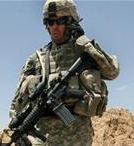If the unmanned vehicles and systems’ community could trade acronyms for  dollars, we’d pay off the national debt. One particular acronym, OPV (Optionally Piloted Vehicles), is popping up all over the place. Northrop Grumman unveiled Firebird, an aerial OPV for intelligence, surveillance and reconnaissance that boasts a 65 foot wingspan. The Army’s Unmanned Aircraft Systems Roadmap outlines plans for helicopters that are both manned and unmanned. The Army also developed Autonomous Vehicle Navigation Systems (ANS) specifically for optionally piloted ground vehicles.
dollars, we’d pay off the national debt. One particular acronym, OPV (Optionally Piloted Vehicles), is popping up all over the place. Northrop Grumman unveiled Firebird, an aerial OPV for intelligence, surveillance and reconnaissance that boasts a 65 foot wingspan. The Army’s Unmanned Aircraft Systems Roadmap outlines plans for helicopters that are both manned and unmanned. The Army also developed Autonomous Vehicle Navigation Systems (ANS) specifically for optionally piloted ground vehicles.
Why are we are pursuing technological switch-hitters? One reason is explained in this quote from the LA Times:
“The government is always going to want options with its aircraft,” said Tom Captain, aerospace analyst with Deloitte. “Unmanned aircraft is taking on increasingly difficult missions. However, in the fog of war, there are still situations where you need a pilot’s instinct inside the cockpit.”
Like what? It’s telling, that the analyst didn’t specify which situations required a pilot. It’s true that unmanned systems still can’t perform many tasks, but isn’t that just temporary? As autonomy and other technologies improve, will there be any missions that must be manned?
I’m reminded of early conversations about optionally piloted trucks. The assumption was that tucks would operate unmanned for convoys, but would still need to be humanly driven on bases, and situations that required stop-and-go driving. Google’s experiment with an autonomously driven car kicked the stuffing out of that idea, but clearly we’re not ready to have our entire civilian fleet piloted by unmanned systems. Maybe, OPVs are the modern equivalent of, “That internal combustion engine sure is swell, Mr. Ford, but don’t you think you should design the Model T to be pulled by horses, you know, just in case?”
The title of an Aviation Week article expressed this well: Optionally Piloted – Bridge or Destination? It describes the Army’s intention to make all Chinook helicopters OPV. The idea was that when the manned crews ended their work day, unmanned systems would take over, and thus, extend the helicopter’s operating hours. OPVs were to “…bridge the gap between today’s manned and tomorrow’s unmanned rotorcraft.”
However, the Army had second thoughts about this “bridging” solution, when it saw the price tag. The costs of implementing even a partial unmanned solution are described in the opening lines from Manned Light Aircraft May Edge Out Some UAVs (Aviation Week):
“Unmanned aircraft are useful for countries that can afford them, but many of the world’s air forces, governments and agencies cannot sustain long-term spending on training, personnel, or force structure that UAVs require. A cheaper option is light, Predator-sized, manned aircraft equipped with sensors and weapons designed for the UAV market.”
In other words, unmanned systems are not always less expensive than manned systems. Ironically, some of these costs are personnel; 109 people are required to support the UAVs needed for a single in-theater Combat Air Patrol (CAP). A major impediment to the widespread use of unmanned systems is the manned cost.
Part of the early appeal of unmanned systems was their “disposability.” Cheaper than piloted vehicles, and certainly less important than our warfighters, who cares if they got blown up? However, as unmanned systems successfully take on more and more missions, their value increases. Already, we are hearing stories about soldiers risking their lives to retrieve damaged UGVs and UAVs that are too valuable to be abandoned.
As more infrastructure is created and more personnel are trained (and more manned vehicles are discarded), the inherent cost-effective nature of unmanned systems will reassert itself. In the meantime, OPVs serve as a bridging solution, not just in the sense that unmanned systems can’t do everything yet, but also because it is still cheaper to have human beings sometimes drive the vehicle. In the case of Northrop Grumman’s Firebird, I also suspect that it didn’t hurt that its manned capability means that it can be sold in US civilian markets, something not allowed for UAVs by the FAA.






Manned or unmanned should be an operational choice. Using a modular design, the aircraft can quickly be reconfigured for manned, unmanned, sensors, communications, weapons, fuel etc. A modular aircraft reduces fleet size, training, supply chains, downtime and space requirements. Economics and versatility are the key features of the modular aircraft and prime factors in aircraft selection as illustrated in this article.